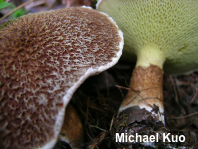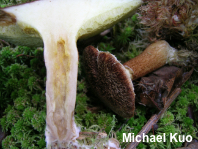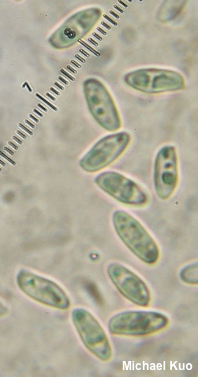| Major Groups > Boletes > Suillus > Suillus ampliporus |

|
[ Basidiomycota > Boletales > Suillaceae > Suillus . . . ] Suillus ampliporus by Michael Kuo, 11 October 2022 This is the North American version of the Eurasian species Suillus cavipes. Like its counterpart, Suillus ampliporus is a distinctive bolete associated with larches, featuring a dry, fibrillose-scaly, brown cap, along with a hollowing stem that bears a collapsing white ring. Until 2016, when Nhu Nguyen and collaborators published a sweeping look at DNA in the genus Suillus, Suillus ampliporus was assumed to be the same as its European counterpart, since they are morphologically inseparable and both associate with larches. However, Nguyen's analysis of ITS sequences from across the globe showed clear separation between the Eurasian and North American groups. Boletinus ampliporus is a synonym. Description: Ecology: Mycorrhizal with tamarack and western larch; growing alone, scattered, or gregariously; late summer and fall; originally described from New York; distributed in northern and montane North America, where the host trees occur. The illustrated and described collection is from Michigan. Cap: 5–15 cm; convex at first, becoming broadly convex; dry; densely fibrillose-scaly with whitish to brown fibrils over a chocolate brown surface; featuring white partial veil remnants on the margin. Pore Surface: Yellow; not bruising; pores angular and radially arranged, about 1–2 mm across; tubes to 8 mm deep. Stem: 3–5 cm long; 1.5–2 cm thick; equal or slightly club-shaped; yellow and bald toward the apex; brown and velvety below; with a fragile white ring; hollow; basal mycelium white. Flesh: White, or yellowish in places; not staining on exposure. Odor and Taste: Odor fragrant; taste not distinctive. Chemical Reactions: Ammonia black on cap surface; green on flesh. KOH blackish red on cap surface; negative to yellowish on flesh. Iron salts negative on cap surface and flesh. Spore Print: Olive brown. Microscopic Features: Spores 6–10 x 3–3.5 µm; boletoid-fusiform; smooth; hyaline to yellowish in KOH. Basidia 22–25 x 4–5 µm; clavate; 4-sterigmate. Cystidia 30–50 x 4–6; subfusiform; thin-walled; smooth; brownish to yellowish in KOH. Pileipellis a cutis of elements 10–25 µm wide, smooth, hyaline to brownish in KOH, septate; with aggregations of upright hyphae; terminal cells cylindric with rounded apices. REFERENCES: (C. H. Peck, 1873) C. E. O. Kuntze, 1898. (Smith & Thiers, 1964; Snell & Dick, 1970; Smith & Thiers, 1971; Grund & Harrison, 1976; Smith, Smith & Weber, 1981; Arora, 1986; Phillips, 1991/2005; Lincoff, 1992; Both, 1993; Barron, 1999; Bessette, Roody & Bessette, 2000; McNeil, 2006; Miller & Miller, 2006; Kuo, 2007; Trudell & Ammirati, 2009; Kuo & Methven, 2014; Bessette, Roody & Bessette, 2016; Nguyen et al., 2016; Baroni, 2017; McKnight et al., 2021; MacKinnon & Luther, 2021.) Herb. Kuo 09120401. This site contains no information about the edibility or toxicity of mushrooms. |
© MushroomExpert.Com |
|
Cite this page as: Kuo, M. (2022, October). Suillus ampliporus. Retrieved from the MushroomExpert.Com Web site: http://www.mushroomexpert.com/suillus_ampliporus.html |


